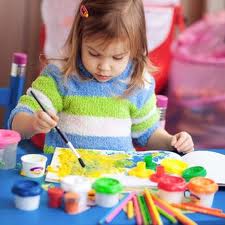Teaching a Child vs. Letting Them Explore

There are many times when it is easier and faster for adults to jump in and help a child get something done, even during play time. Showing children where a puzzle piece fits, how to dress a doll properly, or how to make noise with a musical instrument, might seem helpful to most, but can showing children how to use toys actually be harmful?
While there are very important and specific times that an adult should direct and educate a child on how to do something, there are also times where it is important for a child to explore and even struggle with something in order to figure things out on their own. Deciding when the right times are to teach versus explore is a controversial topic among parents and educators.
An interesting research project was done recently that takes a look at this question. The research explained that when children are shown how to use a toy, they typically will only use that toy in the way it was shown to them, instead of letting them explore the different possibilities and options that a particular toy allows. To read more about this study go to http://econ.st/jnlewr
Encouraging growth, exploration and creativity is an important part of a child’s brain development. If you have adequate time and you and the child are in a safe environment, we have listed some examples of where letting a child explore on their own, versus offering instructions might be beneficial.
1. Art Projects- while using play- doh, clay, markers, crayons, pipe cleaners or other materials, try and allow your child to create something that they are capable of and wanting to make. “Mom, draw me a dog please”. You could respond, “ Why don’t you draw what you think a dog looks like first”. Showing them pictures (from a book, computer or other), is appropriate if the child is younger and might still be learning the names of different objects. Place the picture next to them, and still let them try and draw the object on their own. The same techniques can be used for other art materials.
2. Games-yes, at some time they are going to need to learn the “real rules” of Candyland or soccer. However, just because they might be a bit young to follow the rules, you can still pull out the Candyland box, or that soccer ball and allow some creative exploration. You’d be surprised how children will come up with their own ways to play a game using the pieces and equipment provided. Encourage them by playing along and asking questions.
3. Toys- most toys are designed for specific reasons, meaning the adults who created them, envisioned the toy working in only a few ways. Let your child explore their toys on their own. It might seem to you that the toy is meant to do one or two things, but letting your child’s creativity and thought process wander will bring new uses for the toy and increased brain development, creativity and thought processing.
While we encourage you to experiment with the ideas above, it’s important to note that there are also important times when children should be told and shown what to do or how something works. We recommend taking some time, offering specific instructions, modeling, and detailed explanation for the areas listed below.
1. Hygiene-washing hands, using the toilet…
2. Safety- hot stoves, crossing the street…
3. Respect- for people, situations, themselves and toys
We could add many items to both of the above lists, so please don’t think this is a complete list! It is merely our ideas to help get you as an adult thinking about how and when to incorporate times both for exploration and times for teaching a child. We are here at www.ifnotyouwho.org to answer any of your questions. Thanks for stopping by!
